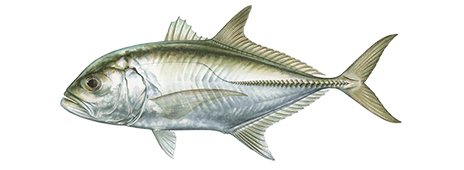
Horse-eye Jack
The Horse-eye Jack is a good light-tackle game fish.

Region
South, Northeast
Catch ease
Medium
Habitat
Bay, River, Ocean
How to identify a Horse-eye Jack
The body is compressed, though the profile of the head is not as vertical or as blunt as in large crevalle jacks, Caranx hippos. The eyes are characteristically large and have thick, adipose eyelids. There is a small black spot on the operculum, but there is no spot on the pectoral fin as in the crevalle jack. The straight portion of the lateral line has 32-39 scutes.
Where to catch Horse-eye Jack
Occurs throughout the Atlantic Ocean; New Jersey on the U.S. coast to Rio de Janeiro, Brazil, including Bermuda, the Bahamas and West Indies in the western Atlantic and off the coast of Africa in the eastern Atlantic. In the Pacific and Indian oceans it is replaced by its close relative, the bigeye trevally.It occurs in small schools around offshore islands and reefs, deep bluewater holes, channels adjacent to flats, and inshore along sandy beaches. It is also known in brackish water and, occasionally, in freshwater coastal rivers and streams. The following list includes additional details on where to catch this fish:
how to catch Horse-eye Jack
It feeds primarily on fish, but also on shrimp, crabs, and other invertebrates. It is a good light-tackle game fish that can be taken with live baits such as mullet, pinfish, or other small fishes, as well as with plugs, jigs, spoons and flies. Lures should be retrieved at a fast pace without slowing or stopping. The following are fishing methods used to catch this fish:
Horse-eye Jack lures, tackle & bait
The following are lures, tackle or bait that can be used to catch this fish:
